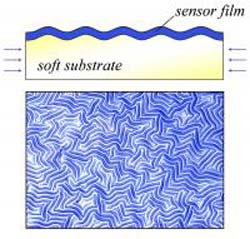Soft materials buckle up for measurement

NIST researchers developed a new high-speed method for measuring the stiffness of soft-polymer materials like those used in contact lenses. The test material is covered with a sensor film, and the combination is compressed until it buckles. The resulting pattern of ridges is the key to determining stiffness, an important material property. Credit: NIST
The new method uses “sensor films” with known properties to report the stiffness (or “modulus”) of the soft substrates to which they are attached. Compressing the sample causes the sensor film to buckle, resulting in patterns of repeating ridge-like features, akin to corrugated cardboard. The ridge spacing is related to the modulus ratio between the film and the soft substrate. Since the mechanical properties of the sensor film was known, the researchers could calculate the stiffness of the soft material underneath.
In the journal article, the team focuses on results achieved with model soft specimens, such as silicone polymer, and more challenging “hydrogel” specimens (networks of polymers swollen with water). In each case, the researchers tested “gradient” specimens that changed in their mechanical properties across the lengths of a sample. With the sensor film, they could track and measure changes in stiffness in the underlying materials.
This capability makes it possible to “map” spatial variations in rigidity in complex materials and devices. Accordingly, the new method may be a powerful tool to test for flaws or weak regions in soft materials products, the researchers suggest.
Another key aspect of the technique is its speed. The NIST team is working with industrial partners to harness this method as a high-throughput measurement tool for rapidly testing large numbers of soft polymer products. For more information on this aspect of the research, see the NIST Combinatorial Methods Center Web site (www.nist.gov/combi).
Media Contact
More Information:
http://www.nist.gov/combiAll latest news from the category: Materials Sciences
Materials management deals with the research, development, manufacturing and processing of raw and industrial materials. Key aspects here are biological and medical issues, which play an increasingly important role in this field.
innovations-report offers in-depth articles related to the development and application of materials and the structure and properties of new materials.
Newest articles

Detector for continuously monitoring toxic gases
The material could be made as a thin coating to analyze air quality in industrial or home settings over time. Most systems used to detect toxic gases in industrial or…

On the way for an active agent against hepatitis E
In order to infect an organ, viruses need the help of the host cells. “An effective approach is therefore to identify targets in the host that can be manipulated by…

A second chance for new antibiotic agent
Significant attempts 20 years ago… The study focused on the protein peptide deformylase (PDF). Involved in protein maturation processes in cells, PDF is essential for the survival of bacteria. However,…





















